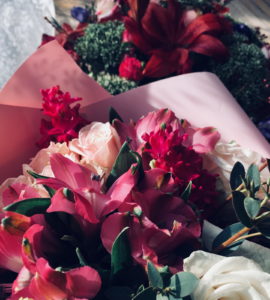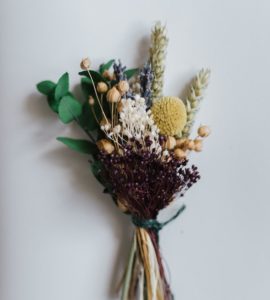Bouquet decoration is of the same importance as its filling: an unsuccessfully chosen decor can ruin even an expensive exquisite gift. There is no one-size-fits-all way to decorate plants so that they are guaranteed to please the recipient. Each design case depends on who, from whom and for what reason the composition is intended.
The main thing in the work of a florist is to maintain harmony: the elements of the floristic design should match in style and mood, set off each other or contrast. To turn scattered buds, beads and wrapper into a single piece, you need to keep in mind the basic rules of design.
Packaging should only highlight the flowers. You cannot choose a wrapper that surpasses them in brightness: it will divert attention to itself, and the impression of the gift will be ruined.
Transparent plastic wrap can only be used as a transport wrap. It is better to present a bouquet completely without packaging than in cellophane.
Accessories (beads, sequins, appliques on skewers, artificial ice and lace) are not suitable for all compositions. They need to be used very carefully.
The bouquet should be packed in accordance with its shape. Florists distinguish round, cascading, triangular, crescent, frame and non-standard forms, as well as their particular interpretations. The principles of decorating bouquets of even the same type can vary greatly. So, round flower sketches such as bridal bouquets should be packed in such a way that only the legs and lower layers of the composition are wrapped. But large round flower “glades” can be packed in a voluminous multilayer wrapper, which greatly exceeds the size of an armful of plants.
Trends in the packaging of floral compositions tend to use eco-friendly or discreet materials. Restraint and minimalism are in fashion. At the same time, the variety of decor provides a rich choice of packaging.
Suitable for sketches of small plants with many inflorescences (bush rose), and for large buds on long stems (roses, peonies, gerberas). The mesh is not only of different colors, but also of different types: florists use sisal (organic agave fiber), chain-link (intersection of wavy stripes in the material), jute mesh (similar to burlap), lace “spider web” and snow mesh decorated with sparkles or by spraying small crumbs.
The grid holds its shape well and emphasizes the beauty of the composition without overloading it with unnecessary details. The airiness of the material visually lightens heavy structures. Suitable for multi-layered wrappers (e.g. combined with felt).
Like mesh, wrapping paper comes in a wide variety of colors, patterns, textures and designs. The paper design will look spectacular, and for plants this option is quite practical: protecting the stems from weather conditions, the paper does not fog up from the inside under the sun, like polyethylene.
Each type of paper has its own peculiarity: kraft paper and parchment go well with jute and twine, corrugated paper is easily deformed into bulk waves, and newspaper packaging can be made multilayer using this material alone. Paper wrapping materials have a significant drawback: they are afraid of water. Florists give the following advice: if you really want to see crumpled paper in your design, use it as the inner layer of a multi-layer wrapper.
A separate type of paper packaging is Korean tracing paper. The bouquets of flowers decorated with this material are not only attractive in appearance. Tracing paper has no shortage of paper wrappers: the composition can be wrapped in Korean paper and put in a refrigerator or container with water. The water resistance of the tracing paper ensures an increase in demand for it in the fall, when the flowers can get caught in the rain. In addition, when the tracing paper is folded, creases are not formed on it. It goes well with silence and parchment. Suitable for creating layered wrappers.
This material is a foamed rubber that is produced in thin, soft sheets. Foamiran is also called revelor or plastic suede. It is impervious to moisture, so it can be used for decoration in floristry at any time of the year. He also has a drawback: too thin sheets of revelor heat up even from the warmth of the hands and can lose their shape (stretch). Plastic suede packaging looks self-sufficient and does not need additional details.
Translucent lightweight material, which is used to create a “marshmallow” compositions. It keeps its shape well, does not wrinkle. It gives the floristic sketch airiness, emphasizes the tenderness of plants and sets off luxury. Can be plain or patterned. Lurex threads can be added to organza fabric: this gives the fabric a festive shine.
Fibrous, tactile, eco-friendly material that goes well with other gift wrapping. Distinguish between silky, embossed, laminated, shiny, monophonic, printed felt. Protects stems from sunlight and dirt. Not afraid of water.
In the design of bouquets, you can do without decor as such: a hat, round, square or rectangular box will perform its role. In addition to the decorative function, the box in such compositions also serves as protection for the buds. At its bottom there is a wet floristic sponge or a reservoir of water, keeping the freshness of a floristic sketch for a long time.
There are usually no packing elements in the boxes, but the decoration of the flowers in the box is complemented by decorations of a different type: sprigs of gypsophila, fern, palm leaves, rattan balls, ting-ting, moss, shells, bleached or dyed coconut leaves. The box can also be used with lining fabric (satin, silk, felt, organza) or paper (tissue, parchment, matte floristic.
Minimalistic solutions are suitable as a gift for men and strict women, for a walk or a photo session. In these cases, catchy details and bright lush packaging are useless: the decor should be discreet or modest.
A bouquet of tulips, ranunculus or roses can only be decorated with a satin ribbon. It can be in tune with the buds or contrasting, but not brighter than plants. You can let the ends of the ribbon fall in waves along the legs of the stems, tie the decoration in a bow, cut into thin stripes and curl into tight curls.
An armful of wild plants, sunflowers or dried flowers can be tied with twine or jute. Such a design is permissible even for Biedermeier-type wedding bouquets: jute rings are fixed as close to each other as possible, thus forming a leg.
Mono-bouquets made of gerberas, poppies or dahlias can be intercepted in the middle of the stems with pieces of fabric. These flowers look self-sufficient in vases and without decor, and on the way home, fabric ribbons will help the plants not to crumble.


